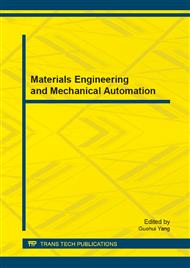p.338
p.342
p.349
p.354
p.360
p.367
p.372
p.381
p.386
Detection of Crack Travel and Opening of a Standard Notched Specimen Mode I Using Embedded FOS Device
Abstract:
Crack detection and monitoring has become one of a focus center for the health monitoring of engineering structures under the influence of mechanical deformation.This paper discusses the detecting, tracking and monitoring mechanisms for the crack, by initiating a sensing system by using a standard notched specimen. Crack features such as magnitude of crack travel versus crack opening are displacement indicators that can vary due to the applied load on the normal line to the direction of the crack travel. More ever, the rate of the crack opening is considered to be proportional to the rate of the crack travel.Lines of three optical fibers of 125 nm are embedded and fixed at two ends and pass across the direction of the crack travel at an approximation of 2mm apart. The light of 2V from the source is passed through the optical fiber, across the crack tip. The crack opening forces the optical fiber to extend under tension, and hence the interruption of its diameter. This causes the decrease in the light intensity traveling through the fiber till the total failure of the fiber, to declare presence of crack. The embedded fiber optics on the specimen links the instrumentation optical system which permits the light beam throughput. Finally the converted light beam into voltage domain allowed us to closely analyze the crack tendency, and eventually be able to establish a model and sensor equation which governs the trend of the crack growth.
Info:
Periodical:
Pages:
360-366
Citation:
Online since:
October 2013
Authors:
Price:
Сopyright:
© 2014 Trans Tech Publications Ltd. All Rights Reserved
Share:
Citation:


